The context
Displacement in the context of disasters and the adverse effects of climate change (disaster displacement),represents complex challenges for affected States and the international community. Disaster displacement is mainly internal, and often short-term, but some displaced persons cross borders to seek refuge abroad. While these persons do not, as such, qualify as refugees under the 1951 Convention on the Status of Refugees, persecution may occur in disaster contexts, or human rights norms may prohibit forcible return to countries affected by disasters and adverse effects of climate change. In other situations, regional refugee frameworks or humanitarian considerations may be applied to permit the admission and temporary stay of such persons.
Recognizing these challenges, the Global Compact on Refugees (GCR), resonating with the principles of the Nansen Initiative Protection Agenda, calls on relevant stakeholders in paragraph 63 to take into account “national laws and regional instruments as applicable, as well as practices such as temporary protection and humanitarian stay arrangements, where appropriate.” Further to this, UNHCR published legal considerations on the applicability of international and regional refugee and human rights law when cross-border displacement occurs in the context of disasters and the adverse effects of climate change.
At the Global Refugee Forum (GRF), the Platform on Disaster Displacement (PDD) and UNHCR will also publish a joint Policy Brief on Protection of persons displaced across borders in the context of disasters and the adverse effects of climate change, highlighting good practices to support implementation of the GCR.
Collectively, these documents underscore a number of tools and effective practices that States have at their disposal to provide protection and assistance for persons displaced across borders in the context of disasters and the adverse effects of climate change, including:
- Harnessing the potential of the 1951 Refugee Convention and regional refugee law.
- Providing complementary protection.
- Providing humanitarian visas or temporary protection.
- Integrating measures for disaster-affected persons in regional and bilateral migration agreements.
- Developing immigration quota schemes.
- While numerous tools exist, their use is often hard to predict and seldom harmonized nor coordinated across regions.
Key messages for 2023 Global Refugee Forum
1. Further guidance on when international or regional refugee and human rights law apply in disaster contexts is needed to better address the challenges of disaster displacement.
- This includes developing specific guidance for decision makers to systematically consider factors related to disasters and adverse effects of climate change when deciding applications for refugee status and assessing whether complementary protection should be granted.
- It also requires the systematic integration of the issue of persecution occurring in disaster situations, particularly in situations of displacement arising due to overlapping and multiple drivers (‘nexus situations’), into the training of decision makers and of relevant disaster and climate change-related facts and analysis in country-of-origin information.
2. Humanitarian protection tools and migration pathways should be further developed, strengthened, and harmonized.
- Further development, harmonization, and application of tools such as humanitarian visas and temporary protection should be supported, for example by drawing inspiration from models such as Argentina’s Special Environmental Humanitarian Visa Programme and Italy’s short-term residency permits in calamity situations.
- This process can be supported by integrating disaster displacement considerations into existing legal frameworks, such as free movement agreements, or concluding bilateral agreements for the permanent stay of persons, in cases where adaptation in or return to countries of origin is not possible.
- The introduction of immigration quotas for individuals from countries particularly affected by disasters and climate change can provide a structured and legal pathway for a certain number of people.
3. International support to hosting countries should be expanded.
- Donors should strengthen their support to hosting countries by explicitly including and addressing cross-border disaster-displacement in their programs and projects, whilst not neglecting efforts to reduce greenhouse gas emissions and managing disaster displacement risks in countries of origin.
Header Photo © UN/MINUSTAH









